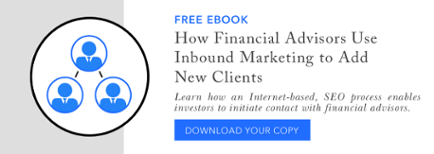

Who’s Your Audience? Marketing Financial Planning Services to a Specific Persona Gets Better Results
You’ve started your firm. You employ many strong and educated individuals to help you reach success. You’ve identified what financial planning services you want to offer. You know how important your financial advisor marketing plan is. You may even have an inbound marketing plan in place. But do you know who your audience is? Who specifically you will be marketing financial planning services to? This is actually a very important step.
Financial advisors who have been in the industry for a while have probably learned the value of identifying your target markets and knowing your ideal client. However, in the past, advisors may have set out to build a profile consisting largely of demographic information with a smattering of needs and wants. For some of the older marketing processes, these kinds of profiles helped advisors narrow their markets and focus on finding their ideal clients. But now, we encourage a more specific approach, so an advisor knows exactly what types of clients he or she is trying to attract through their marketing efforts.
For example, if your target market is high-net-worth families, and your website approach tries to speak to all high-net-worth families, it will most likely fail to speak to many of them. High-net-worth individuals aren’t likely to spend much time on a website or reading a blog if it can’t immediately answer, “What’s in it for me?” That’s true of most people who look to the web for answers and solutions. Millennials can be especially picky about how they spend their time on the Internet. Chances are they have already spent a fair amount of time searching and researching, and, if they find their way to your website, they’ll know instantly if there isn’t anything of value to be found.
To get to the point where you can identify with a specific audience segment and communicate in a way they can identify with, you need to go beyond the generic profile to build a much deeper persona that includes who they are, what they do, how they think, how they talk and how they respond to people like you. That’s just for starters. Ultimately, you should create a client persona for each of the particular services you are marketing. In doing so, you will be able to narrow your focus in all aspects of your business to create better opportunities to find and attract your ideal client.
Creating fresh, relevant content for your website or blog can be a challenge. Say goodbye to writer's block! Download our Free eBook: 5 Ways to Source Content for Your Financial Advisor Blog & Website
What Exactly is a Client Persona?
Staying with the generic client profile for a moment, a client persona is similar in that it does seek to identify the type of client you consider to be ideal for your practice and expertise. The difference is a client persona goes much deeper into identifying specific traits and characteristics and other ways in which this person is influenced when making decisions. The general client profile is built from your perspective, while the client persona is created from your ideal client’s perspective.
When you create a client persona, you are creating a detailed representation or composite of your ideal client. The client persona then becomes your narrative framework that will guide you in all your messaging, marketing, communication and cultivation efforts. Depending on your marketing scope, especially if you are marketing yourself as a virtual advisor, you may want to create three or four personas that represent the ideal client from different audience segments you want to target.
An Example of a Completed Client Persona:
Client Persona: Frank Founder
Background:
- President and founder of Founder Manufacturing which he founded 30 years ago
- B.S. degree in economics
- M.B.A. Business Management
- Married 35 years; three children; six grandchildren
Demographics:
- Male
- Age 60
- HH Income: $350,000
- Net Worth: $8.7 million
- Lives in suburban, single-family home
Goals:
- Successful transition into retirement
- Create a business succession plan
- Expand financial and volunteer contributions to community and charity
Hobbies/Interests:
- Spending time with family
- Skyping with children and grandchildren
- Community activities
- Reading financial blogs
- Golf
Challenges:
- Finding more time for family
- Recruiting new talent to keep the business growing
- Staying on top of technological advancements in industry
Biggest Fears/Concerns:
- Losing valuable employees before or during business succession
- Watching the business falter or fail after retiring
- Not being able to leave a legacy for the family
Preferences:
- Reads personal emails in the evening
- Wants calls returned within 24 hours
- Reads both financial publications (WSJ) and financial blogs
- Will conduct own research before making financial decisions
Remember, Frank Founder is a composite of all the data and information you gathered from your research on your ideal client. If your research was extensive enough – pulling data from client files and interviewing existing clients – you can be confident that your persona is an accurate representation of your target market.
Putting Client Personas to Use
Your client personas form the narrative that frames all communications with your target audience segments. They provide the context around which all your content is developed, including your web content, your blogs, your presentations, even your elevator pitch. You can use your client personas to create a more sharply honed message that will resonate with your target audience.
5 Ways You Can Specifically Use Your Personas:
- Change your website’s perspective. Most financial advisors’ web content is created from their perspective, using their jargon, presenting it the way they view their products and services. Your client personas enable you to create content from their perspective, using their jargon, presenting it the way they want to see it. Remember, you need to immediately answer the question, “What’s in it for me?”
- Refine your presentations. Creating a client persona ensures that your online or in-person presentations conform to the persona you want to attract. You may need to translate one presentation into the context of several personas, using distinct language and shaping the message in a way to appeal to each persona.
- Create more compelling topics. Use the persona narratives to zero in on topics that will be of particular interest to your audience segments. Having a complete understanding of the persona should enable you to personalize the content; maybe using more of a story format than a straight educational format, which is always more compelling.
- Blog to please. Create blog content strategically by posting articles that will appeal to each of your personas. Then, when you are communicating with a prospective client matching one of your personas, you can reference specific blog posts that will reinforce your message in an educational way.
- Design your web marketing strategy around personas: Knowing how your target audience prefers to consume information, you can design your content generation platform to improve the likelihood they will find and actually consume your content.
Financial advisors are finally catching up with the rest of the marketing world in their understanding that traditional marketing approaches no longer work. The Internet has turned the tables to where consumers now control the message. They control what it will say to them, how and when it is to be delivered and whether they will continue to receive it. They know what they want to hear, and if they don’t hear it, they simply move on.
The goal of creating client personas is to humanize your ideal client, so you can you give your content the proper context and tailor it to the audience segment you are trying to attract. It does take some time and effort; however, it will give you the ability to narrow your focus and channel your resources for the most effective and profitable use of your time and effort. If you don’t have the time or interest in making a client persona, there are marketing agencies that will do this for you.

Debbie Freeman
Search Here
Categories
- AI (17)
- blogging (2)
- branding (1)
- content (11)
- custodians (1)
- Digital (534)
- email marketing (3)
- fcmo (3)
- fees (1)
- financial advisor marketing (63)
- Google (3)
- Ideas & Tips (126)
- Investor Experience (7)
- lead generation (7)
- linkedin (1)
- Marketing (602)
- newsletters (1)
- Online Transparency (2)
- podcasting (1)
- search engine optimization (4)
- seo (9)
- Social Media (2)
- video (3)
- Websites (172)
- YouTube channel (2)
Recent Posts
-
 October 10, 2025
October 10, 2025 -

-

7 Critical Mistakes Financial Advisors Make in Digital Marketing
September 29, 2025 -

What Are The Most Effective Graphics For Financial Advisor Websites?
September 25, 2025 -

Top Characteristics of Financial Advisor Newsletters (That People Will Read)
September 22, 2025

